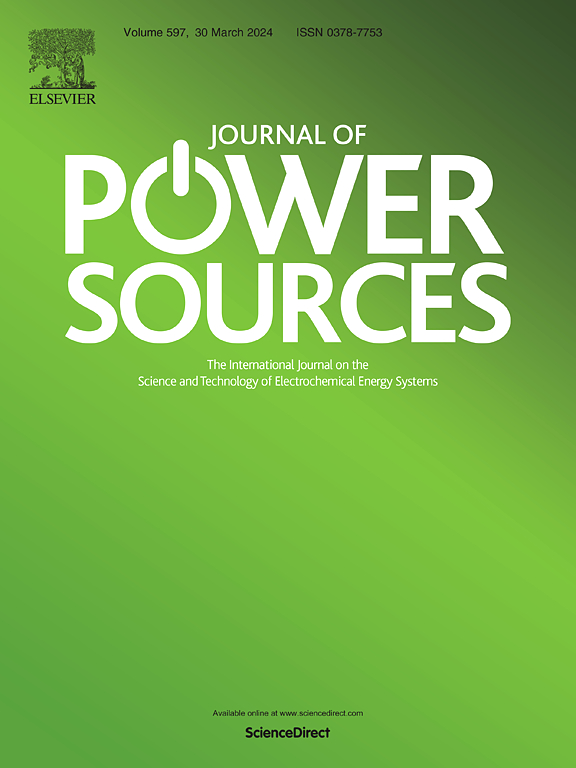用于微米级锂离子电池阳极SiOx的工程自适应复合粘合剂
IF 7.9
2区 工程技术
Q1 CHEMISTRY, PHYSICAL
引用次数: 0
摘要
锂离子电池的高容量硅基阳极由于体积变化大,初始库仑效率低,面临着巨大的挑战,阻碍了其商业化。虽然优化活性材料的固有性能是必不可少的,但粘合剂在提高硅基阳极的循环稳定性和库仑效率方面起着至关重要的作用。在这项研究中,我们提出了一种通过软硬结合策略开发的新型三维网络复合粘合剂。这种粘合剂的特点是天然弹性超分子瓜尔胶(GG),富含羟基,通过氢键与线性刚性聚合物聚丙烯酸(PAA)主链交联。利用其卓越的自适应能力,GG-PAA复合粘合剂显著提高了商用微米尺寸SiOx阳极的效率和耐久性,实现了75.09%的初始库仑效率,并在1.0 ag−1下循环150次后保持了882.2 mAh g−1的容量。这项工作为设计硅基阳极应用的自适应粘合剂提供了一种可行的策略。本文章由计算机程序翻译,如有差异,请以英文原文为准。

Engineering self-adaptive composite binders for micron-sized SiOx in lithium-ion battery anodes
High-capacity silicon-based anodes in lithium-ion batteries face significant challenges due to substantial volume changes and low initial Coulombic efficiency, which hinder their commercialization. While optimizing the intrinsic properties of the active material is essential, the binder plays a crucial role in enhancing the cycling stability and Coulombic efficiency of silicon-based anodes. In this study, we present a novel three-dimensional network composite binder developed through a soft-hard combination strategy. This binder features the natural elastic supramolecule guar gum (GG), rich in hydroxyl groups, which is crosslinked to a linear rigid polymer polyacrylic acid (PAA) backbone via hydrogen bonding. Leveraging its exceptional self-adaptive capability, the GG-PAA composite binder significantly improves the efficiency and durability of the anode composed of commercial micron-sized SiOx, achieving an initial Coulombic efficiency of 75.09 % and retaining a capacity of 882.2 mAh g−1 after 150 cycles at 1.0 A g−1. This work offers a viable strategy for designing self-adapting binders for silicon-based anode applications.
求助全文
通过发布文献求助,成功后即可免费获取论文全文。
去求助
来源期刊

Journal of Power Sources
工程技术-电化学
CiteScore
16.40
自引率
6.50%
发文量
1249
审稿时长
36 days
期刊介绍:
The Journal of Power Sources is a publication catering to researchers and technologists interested in various aspects of the science, technology, and applications of electrochemical power sources. It covers original research and reviews on primary and secondary batteries, fuel cells, supercapacitors, and photo-electrochemical cells.
Topics considered include the research, development and applications of nanomaterials and novel componentry for these devices. Examples of applications of these electrochemical power sources include:
• Portable electronics
• Electric and Hybrid Electric Vehicles
• Uninterruptible Power Supply (UPS) systems
• Storage of renewable energy
• Satellites and deep space probes
• Boats and ships, drones and aircrafts
• Wearable energy storage systems
 求助内容:
求助内容: 应助结果提醒方式:
应助结果提醒方式:


